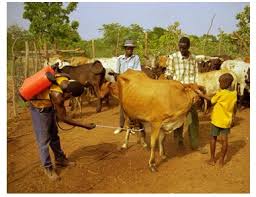Communal farmers’ perceptions on the use of indigenous knowledge in controlling ticks and tick-borne disease (Anaplasmosis) in cattle: a case of Katima rural constituency, Zambezi region Namibia
Keywords:
Tick-borne diseases, Traditional knowledge, Communal farmers, Katima rural constituencyAbstract
Communal farmers in most African countries have used both indigenous and modern knowledge to control ticks and tick-borne diseases. The aim of this paper is to report on the communal farmers’ perceptions on the use of indigenous knowledge in controlling ticks and tick-borne diseases (Anaplasmosis) of cattle in the Katima Rural Constituency, Zambezi Region Namibia. The data was collected using structured questionnaires and analyzed as percentage of the participants. The results show that 85% of the participants are aware of the existence of ticks and tick-borne diseases affecting cattle in the study area and this suggests that the problems are evident in the area. It was also found that the roots, leaves and bark extracts of Muhonono (Terminalia sericia), Mukolotela (Piliostigmathonningii), Muchoko/Itanga (shrub) and Umbwiti/Ligwatanga (shrub) are often used by the farmers in the ethno-veterinary control of ticks and tick-borne diseases. This practice is evident among the older age bracket (51 – 70 years), with the 61 – 70 years old participants indicating complete reliance on the use of ethno-medicine to control their cattle’s ticks and tick-borne diseases. Even though, there is an existing government policy that compels all farmers to vaccinate their animals against all sorts of livestock diseases in order to supply healthy meat to the markets, the financial cost of utilizing the conventional methods appears to be beyond the reach of most of the communal farmers. This effect will continue to promote the use of ethno-medicine in the control of ticks and tick-borne diseases in the study area. Therefore, there is need for government veterinary department to work with the communal farmers in identifying and standardizing the plant extracts for wider applications in controlling cattle’s ticks and tick-borne diseases.
References
Abah, J., Mashebe, P., Onjefu, S., 2014. Some trace metals contentof atmospheric dusts deposition in Katima Mulilo metropolis, Namibia. J. Environ. Sci.Texicol. Food. Technol. 8(2), 5-13.
Bizimana, N., 1997. Available at: http://www.vetwork.org.uk/pune20.htm [Accessed 5 October 2015]. Scientific evidence of efficacy of medicinal plants for animal treatment.
de Waal, D., 2000. Anaplasmosis control and diagnosis in South Africa. Annals of the New York Academy of Sciences. 916, 474-483.
Drummond, R., 1983. Chemical control of ticks. World. Anim. Rev. Tick-borne livestock diseases and their vectors, 36, 28-33.
FAO, 1998. The occurrence of resistance to pesticides in arthropods. An index of cases reported through 1989., Italy, Rome.
Hlatshwayo, M., Mbati, P., 2005. A survey of tick control methods used by resource-poor farmers in the QwaQwa area of the eastern Free State Province, South Africa. Ondersteport. J. Vet. Res. 72(3), 245-249.
Magwede, K., Tshisikhawe, M., Lubesa, D., Bhat, R., 2014. Ethnobotanical survey of medicinal plants used in treatment of ticks. Int. J. Exp. Bot. 83, 155-165.
Mathias-Mundy, E., Mc Corkle, C., 1989. Ethno-veterinary Medicine: An Annotated Bibliography. Bibliographies in Technology and Social change. Iowa, USA:, s.l.: Iowa State University.
Muchenje, V. et al., 2008. Tick susceptibility and its effect on growth performance and carcass characteristic of Nguni, Bonsmara and Angus steers raised on natural pasture. 2, 298-304.
Owen, E., Kitalyi, A., Jayasuriya, N., Smith, T., 2005. Improving the husbandry of animals kept by resource- poor people in developing countries. Livest. Wealth. Creat. Nottingham, UK: University Press.
Peter, R., van den Bossche, P., Penzhorn, B., Sharp, B., 2005. Tick, fly, and mosquito control lessons from the past, solutions for future. Vet. Parasitol. 132(3-4), 205-215.
USDA, 1967. Safe use of agricultural and house hold pesticide. In Agriculture hand book, Washington, D.C.: United-States-Department-of-Agriculture.

Published
How to Cite
Issue
Section
Copyright (c) 2020 P. Mashebe, J. Abah, A. Zulu

This work is licensed under a Creative Commons Attribution-NonCommercial-NoDerivatives 4.0 International License.



